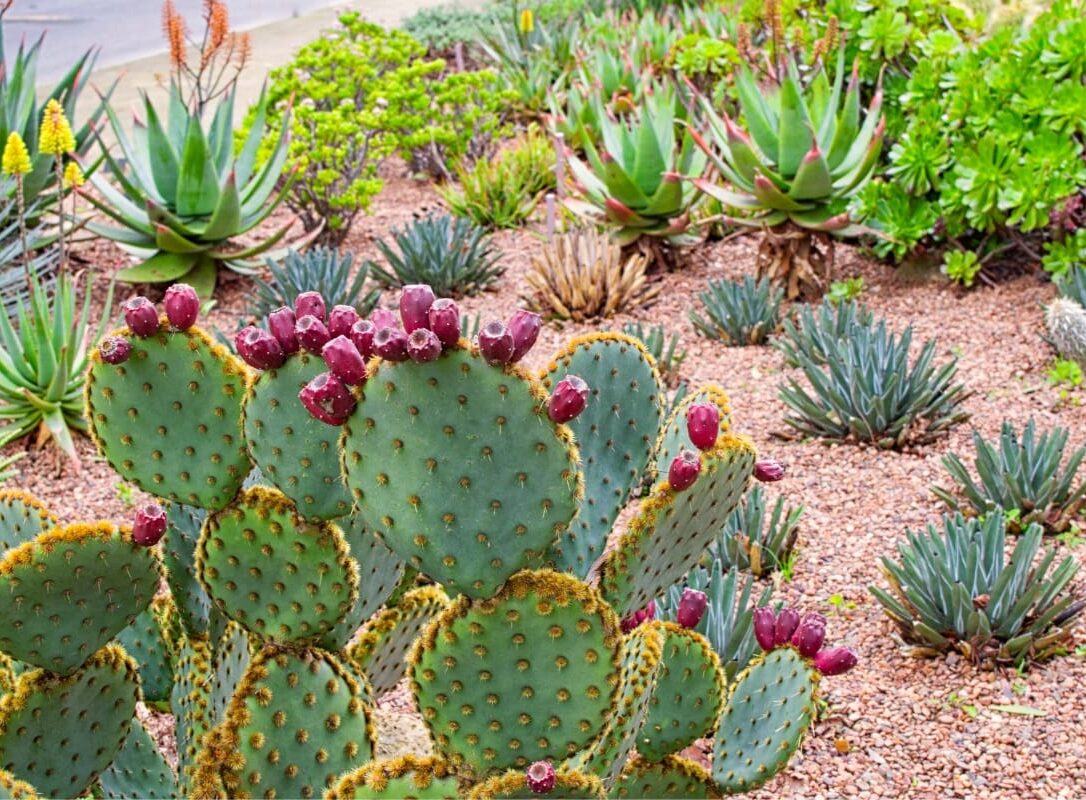Maintaining a lush, beautiful yard in Georgia’s hot and often dry climate can be a challenge—but drought-resistant landscaping offers a smart, sustainable solution. By choosing the right plants, optimizing irrigation, and rethinking your yard’s layout, you can create an outdoor space that thrives even in periods of limited rainfall. Whether you’re dealing with seasonal water restrictions or simply want to lower your water bill, embracing drought-tolerant strategies helps your landscape stay healthy and vibrant year-round. In this guide, we’ll share practical tips for designing a resilient yard that’s both environmentally friendly and visually stunning.
Drought-Resistant Landscaping Ideas That Save Water & Wow
What Are the Best Native and Drought-Tolerant Plants for Georgia Landscapes?
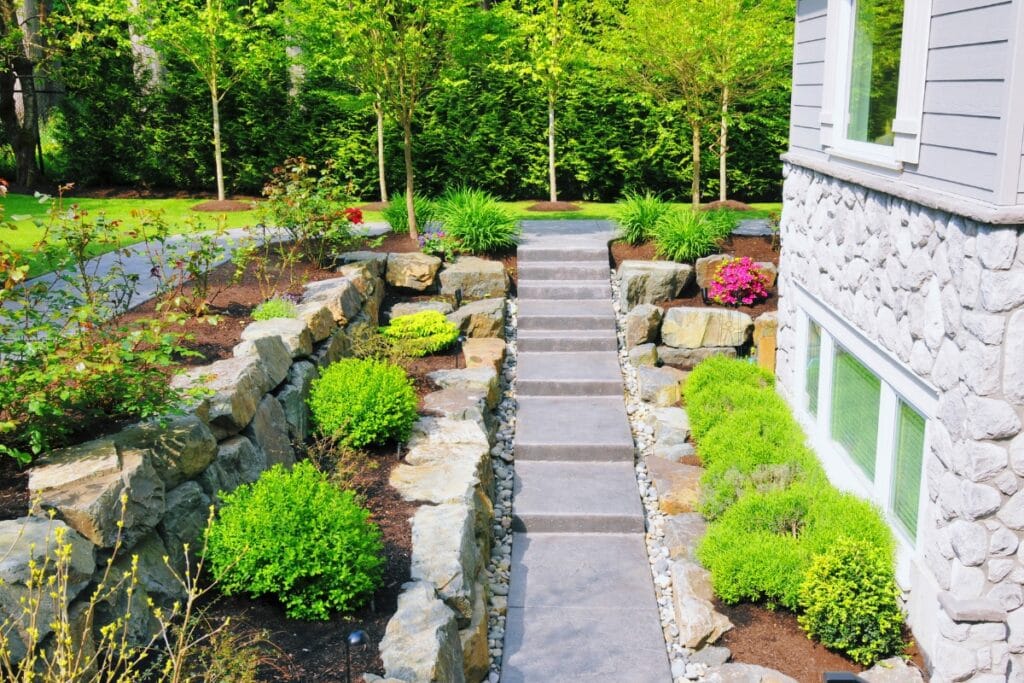
Georgia’s warm climate and unpredictable rainfall patterns make it important to choose plants that can thrive without constant irrigation. Native and drought-tolerant species tend to perform well in these conditions because they have adapted over time to handle heat, dry spells, and local pests. These plants often require less maintenance than non-native varieties and contribute to a healthier ecosystem overall.
Which Native Plants Thrive in Georgia’s Drought Conditions?
Some of Georgia’s most resilient native plants include species like the Georgia aster, butterfly weed, and white oak. These plants are not only tough under dry conditions, but they also support local wildlife such as bees, butterflies, and birds. Many native wildflowers offer seasonal bursts of color, while deeper-rooted perennials improve soil stability and retain moisture underground. Their natural ability to go dormant during prolonged heat allows them to bounce back when rain returns, making them ideal for sustainable landscapes.
What Are Popular Drought-Tolerant Shrubs and Groundcovers?
Shrubs like American beautyberry and yaupon holly are good choices for their aesthetic appeal and hardiness. They add interest to the landscape with colorful berries, textured leaves, and seasonal variation, all while requiring less water than traditional garden shrubs. For ground coverage, creeping thyme and sedum are popular for their ability to spread quickly, suppress weeds, and hold moisture in the soil. These low-growing plants serve as living mulch, keeping root zones cool and shaded.
How Do Succulents and Ornamental Grasses Fit Into Drought-Resistant Designs?
Succulents such as sempervivum and agave offer a practical and visual solution for dry areas. Their ability to store water in thick leaves makes them incredibly efficient during periods of limited rainfall. These plants are also excellent for containers, rock gardens, or areas with minimal soil. When paired with ornamental grasses like blue fescue, muhly grass, or pampas grass, they bring texture and contrast to the yard. Many ornamental grasses are well-suited to poor soil and can help reduce erosion on sloped or uneven land.
Together, these plants form a landscape that is both attractive and functional. By choosing species that thrive in Georgia’s natural climate, homeowners can reduce water use, cut back on fertilizers and chemical treatments, and create a more balanced outdoor environment. This approach not only saves time and resources but also encourages pollinators and other beneficial wildlife to return year after year. Whether you’re updating an existing garden or starting from scratch, native and drought-tolerant plants offer a smart, sustainable foundation for any Georgia landscape.
How Can You Design a Water-Efficient Landscape for Georgia Yards?
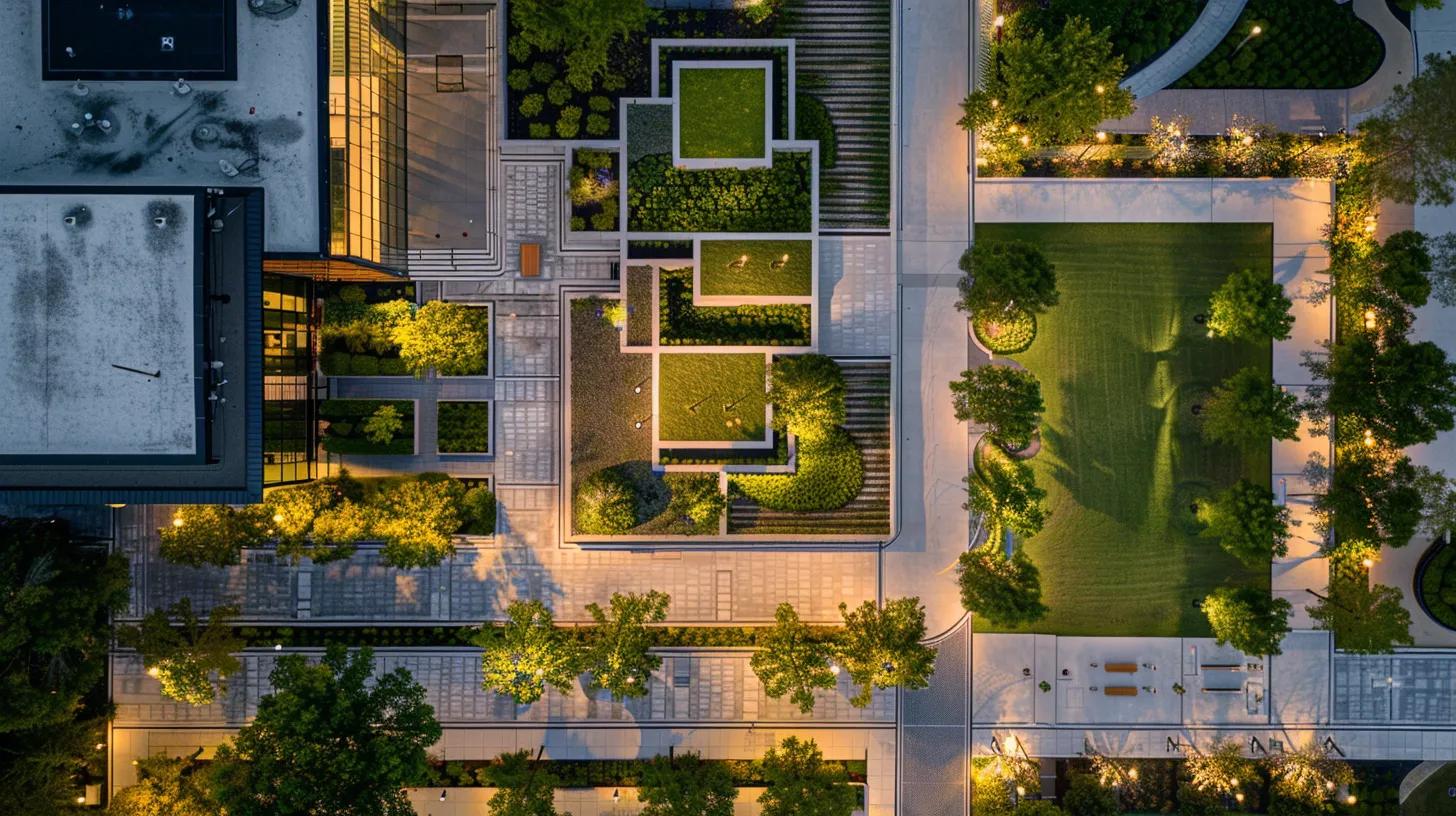
Designing a water-efficient yard in Georgia starts with a clear understanding of the local climate, seasonal rainfall, and your specific soil conditions. With hot summers and periods of drought becoming more common, it’s important to be thoughtful about how water is used across your landscape. Dividing your yard into specific zones—such as areas for walking, decorative plant beds, and turf—allows you to adjust irrigation to meet the needs of each space. This targeted approach can significantly reduce waste without sacrificing the health or appearance of your yard.
What Are Key Principles of Sustainable Landscape Design?
The core idea behind sustainable landscape design is to work with your environment, not against it. Start by analyzing how sun, wind, and water move through your yard. Consider how slopes affect drainage, whether certain areas get more shade or direct sunlight, and how compacted or loose your soil is.
From there, select plants that naturally thrive under those conditions and require less watering overall. Integrating elements like rain gardens and permeable walkways helps redirect and reuse rainfall, reducing the need for supplemental watering. These small adjustments build toward a landscape that uses fewer resources over time while still looking attractive and functioning well.
How to Incorporate Hardscaping and Mulching for Water Conservation
Hardscaping doesn’t just add structure to your yard—it also plays a role in water management. Permeable pavers, gravel paths, and strategically placed stone walls can help direct rainwater toward areas where it’s needed most, such as planting beds. When combined with mulch, these features become even more effective.
Organic mulches like bark chips or composted leaves retain moisture in the soil by slowing evaporation and shielding the ground from direct sunlight. They also reduce erosion, suppress weeds, and eventually break down to improve soil quality. Together, these practices cut down on how often you need to water while helping plants stay healthier for longer.
What Role Do Soil Types and Amendments Play in Drought-Resistant Landscaping?
Soil is the foundation of any landscape, and in Georgia, it can vary widely from one yard to the next. Sandy soils tend to drain too quickly, while heavy clay can hold too much water and limit root growth. Either extreme can lead to plants that struggle or require extra attention. To improve your soil’s ability to retain the right amount of moisture, consider adding compost or other organic matter. These amendments help loosen compacted clay, improve drainage in sandy areas, and increase the availability of nutrients. Matching the right plants to your improved soil type further supports a resilient, low-maintenance yard.
When these strategies come together—careful planning, smart plant choices, well-placed hardscaping, consistent mulching, and soil improvement—they form a landscape that looks good, functions well, and uses water wisely. Over time, a water-efficient yard not only reduces your utility bills but also supports a healthier, more adaptable outdoor environment.
Which Irrigation Methods Are Most Effective for Drought-Resistant Yards in Georgia?
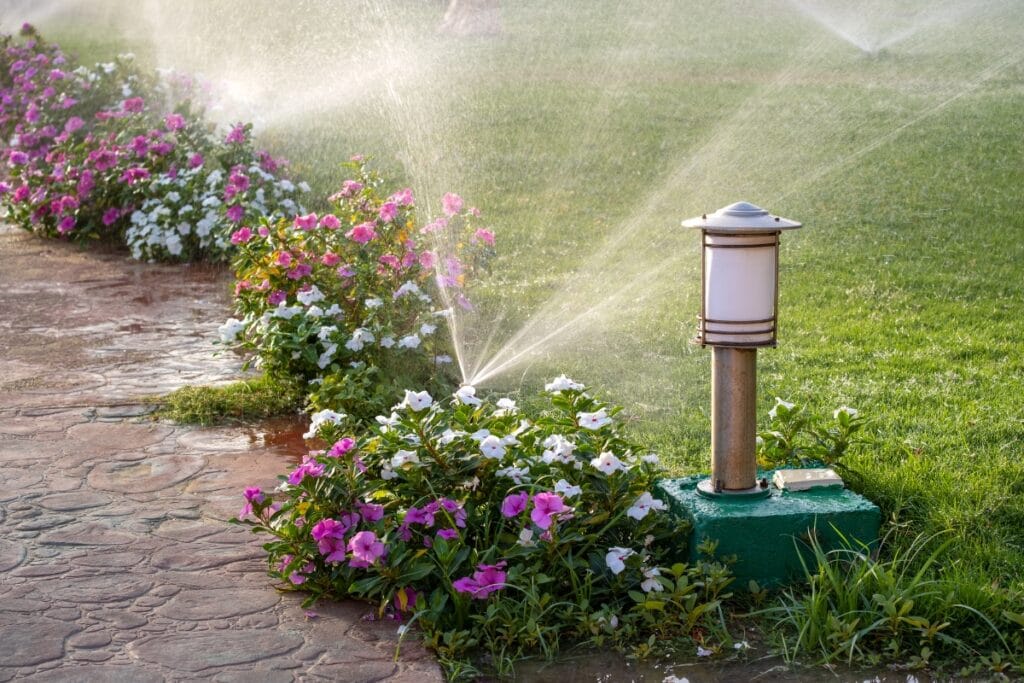
In Georgia, where hot summers and irregular rainfall are common, efficient irrigation plays a critical role in maintaining a healthy landscape without wasting water. The right system delivers water precisely where it’s needed, helping plants thrive while avoiding runoff, evaporation, and overwatering.
How Does Drip Irrigation Save Water Compared to Traditional Sprinklers?
Drip irrigation is one of the most efficient ways to water plants, especially in drought-prone areas. Unlike traditional sprinkler systems that spray water across a broad surface, drip irrigation delivers water slowly and directly to the soil at the base of each plant. This targeted method reduces evaporation and limits the amount of water lost to wind or runoff. Because the moisture goes straight to the root zone, it promotes deeper root development and better drought tolerance.
Drip systems also help reduce the risk of fungal issues and weed growth, since water doesn’t sit on the leaves or soil surface. This creates a healthier growing environment and cuts down on unnecessary maintenance. For homeowners looking to conserve water without sacrificing plant health, drip irrigation offers a practical, long-term solution that aligns with Georgia’s water conservation efforts.
When Should Soaker Hoses Be Used in Water-Wise Gardens?
Soaker hoses provide another simple and effective way to keep plants hydrated while minimizing waste. These hoses slowly release water through their porous walls, allowing for even coverage along the length of the hose. They’re especially useful in densely planted garden beds or around the base of shrubs and perennials.
Because soaker hoses work best when water pressure is kept low and consistent, they should be used during cooler times of the day, such as early morning or late evening. This helps ensure that more water is absorbed by the soil rather than evaporating into the air. Adding a timer to the hose setup makes the system even more efficient, providing consistent watering without constant manual adjustment. Soaker hoses offer a low-cost alternative to more advanced irrigation systems and can easily be integrated into existing landscapes.
How Can Smart Irrigation Controllers Optimize Water Use?
Smart irrigation controllers take water efficiency a step further by automating the process based on real-time data. These devices adjust watering schedules based on local weather forecasts, temperature, humidity, and even soil moisture levels. This means the system will pause watering during rain or adjust the amount based on how much water is already in the soil.
This type of technology reduces water waste and helps maintain optimal soil moisture levels for plant health. Homeowners benefit from fewer dry spots, healthier lawns and gardens, and lower utility bills. Over time, smart controllers also reduce wear on irrigation components by preventing unnecessary operation.
Combining smart technology with efficient delivery methods like drip irrigation or soaker hoses allows Georgia homeowners to build drought-resilient landscapes that require less water while still looking their best.
What Maintenance Practices Support Long-Term Health of Drought-Resistant Landscapes?
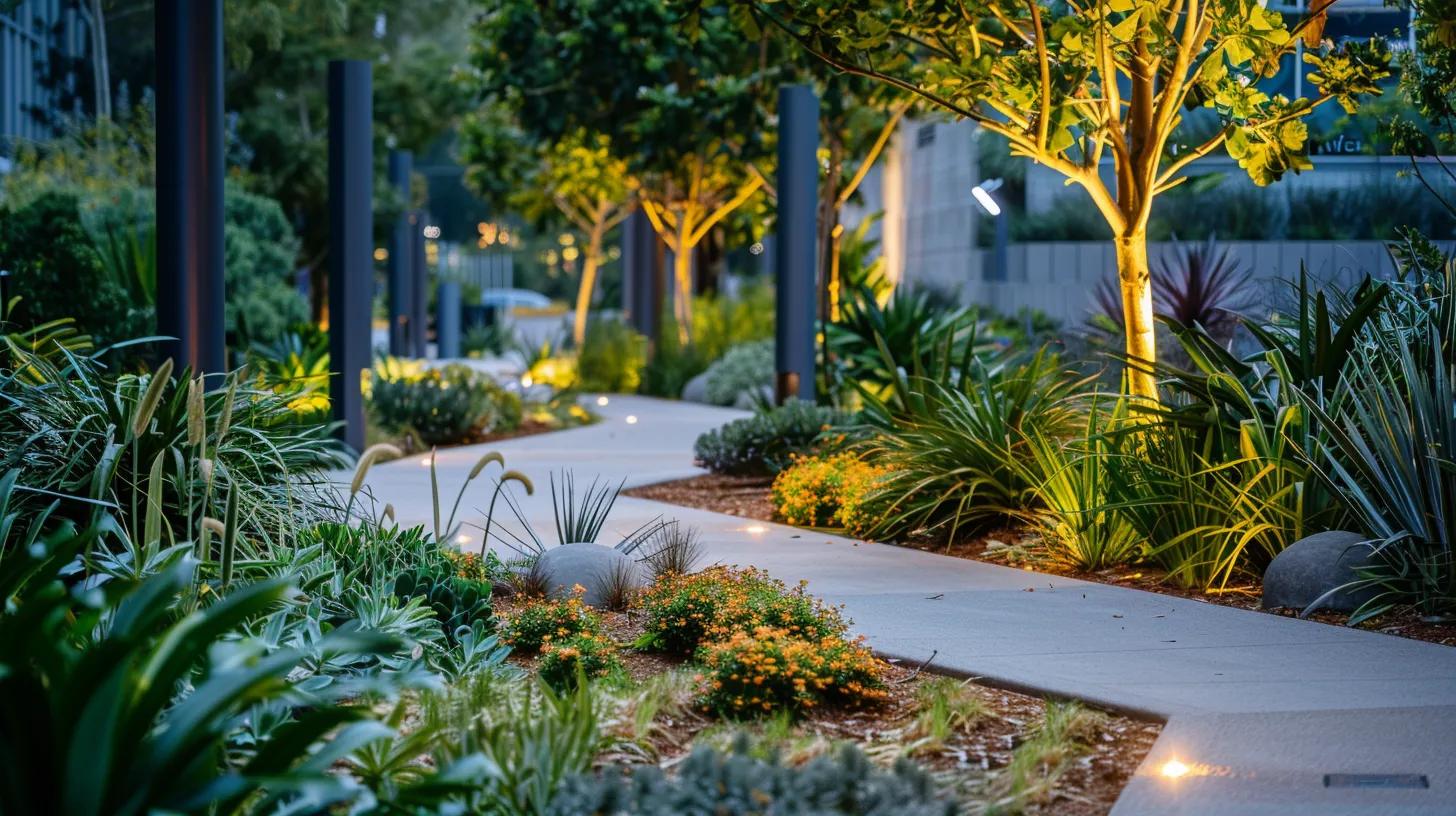
Maintaining a drought-tolerant landscape doesn’t mean the work ends once planting is complete. Ongoing care is key to keeping your plants healthy and your yard looking its best over time. With consistent attention to watering, soil quality, and pest management, a drought-resistant garden can remain both attractive and efficient with minimal water use.
How Often Should You Water Drought-Tolerant Plants in Georgia?
The right watering schedule depends on the time of year and the specific plants in your landscape. During the summer, when temperatures peak and rainfall is less predictable, deep watering once every 7 to 10 days is usually enough for most drought-tolerant species. This encourages roots to grow deeper into the soil, where moisture is more stable. Avoid frequent, shallow watering, which leads to weak root systems and poor drought resilience.
As the seasons change and temperatures cool, watering needs drop significantly. Overwatering in the fall and winter can lead to soggy soil and root rot. Early morning watering is generally best, as it allows moisture to soak in before the heat of the day increases evaporation. For greater accuracy, digital soil moisture sensors can be used to measure when the ground truly needs water rather than relying on a fixed schedule.
What Are Best Organic Fertilizers and Soil Care Tips?
Healthy soil is the foundation of a successful drought-tolerant yard. Organic fertilizers like compost, aged manure, or worm castings improve both nutrient content and soil structure. These materials help sandy soils hold moisture better and improve drainage in clay-heavy areas. They also promote beneficial microbial activity, which supports long-term plant health.
Mulching is another important part of soil care. A layer of natural mulch around your plants keeps soil temperatures more stable, reduces water loss from evaporation, and helps suppress weed growth. Organic options such as shredded bark, pine straw, or composted leaves also break down over time, further enriching the soil. To keep nutrients balanced, consider testing your soil every couple of years and applying amendments based on actual needs rather than guesswork.
How to Manage Weeds and Pests Without Excessive Water Use
Keeping weeds and pests under control is part of maintaining a healthy yard, but it doesn’t have to mean using a lot of water or harsh chemicals. Weeds compete with your plants for water, so pulling them regularly or using natural barriers like dense groundcovers helps limit their spread. Cover crops or mulch can also reduce weed pressure.
Pest control can be approached with an integrated strategy. Attracting beneficial insects like ladybugs or using non-toxic repellents keeps pests in check without disrupting the environment. Proper spacing between plants allows for better air circulation, which lowers the risk of fungal issues often made worse by high humidity and poor drainage.
With regular attention to these key maintenance areas, drought-tolerant landscapes can stay attractive and functional with less water and lower long-term effort.
How Do Georgia’s Climate and Soil Conditions Affect Drought-Resistant Landscaping Choices?
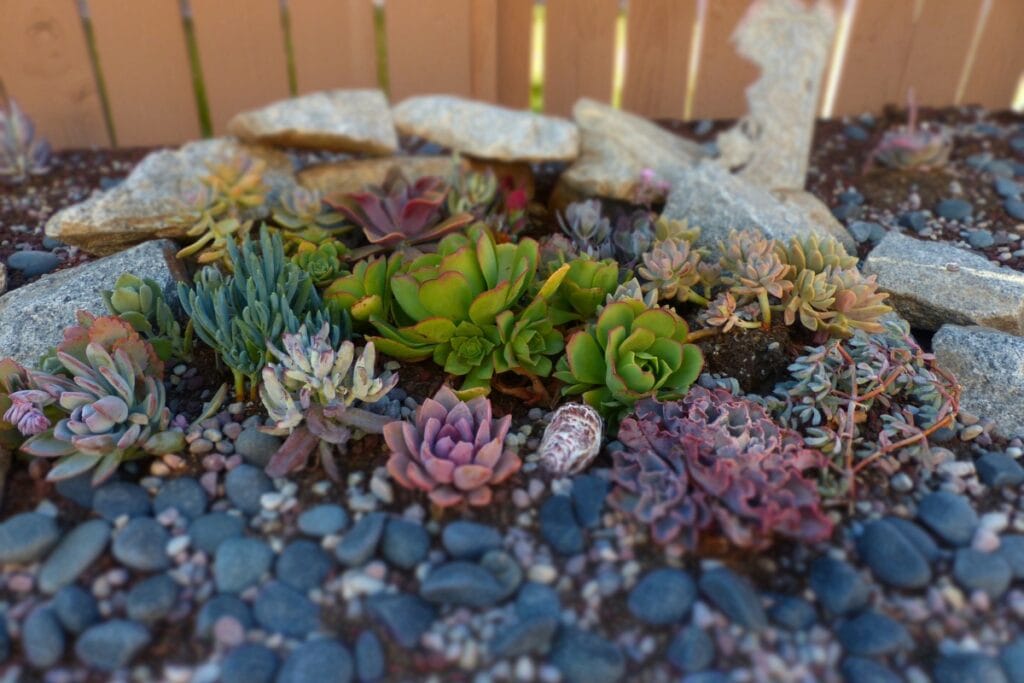
Designing a drought-resistant landscape in Georgia involves more than just picking plants that need less water. The state’s climate and soil conditions play a major role in determining what will thrive and what may struggle. With hot, humid summers and irregular rainfall, homeowners and landscapers need to consider how temperature, water availability, and soil composition interact.
What Are Typical Georgia Climate Challenges for Landscapers?
Georgia experiences high summer temperatures, frequent humidity, and unpredictable rainfall patterns. While heavy storms may deliver large amounts of rain in short bursts, long dry periods often follow. This inconsistency leads to challenges such as shallow root growth, rapid evaporation, and increased stress on plants.
During extended droughts, soil tends to harden and compact, which limits air and water flow to roots. When the ground becomes compacted, microbial life in the soil also declines, which reduces nutrient cycling. As a result, even drought-tolerant plants can suffer without supportive strategies. Mulching, grouping plants with similar water needs, and using shade strategically are common ways to address these issues and help plants better withstand the conditions.
How Does Soil Type Influence Plant Selection and Irrigation?
Soil composition across Georgia is diverse. Some areas have sandy soil that drains quickly and doesn’t hold water well, while others have dense clay that retains moisture but can easily become waterlogged. Both types can create problems without modification.
Amending sandy soils with compost or other organic material helps them hold moisture longer. In contrast, breaking up compacted clay and adding organic matter can improve drainage and root penetration. Soil testing is a useful step early in the planning process. It helps identify pH levels, nutrient content, and texture, which in turn makes it easier to select the right plants and determine how much watering will be needed.
Planting native species that are already adapted to local soil and weather can also reduce the need for irrigation and chemical inputs. Many native plants have deep root systems that access water farther below the surface and are naturally resilient in Georgia’s climate.
What Local Regulations Should Homeowners Know About Water Conservation?
Water conservation rules vary across counties and cities, especially during drought conditions. These rules may include restrictions on watering days, hours, and methods. Some areas limit the use of sprinklers during peak daylight hours or require the use of specific equipment like rain sensors or drip systems.
Homeowners should stay informed about their local ordinances to avoid fines and ensure their landscaping practices are compliant. In some locations, financial incentives may be available for installing efficient irrigation systems or drought-tolerant landscaping. Programs like these support sustainable choices while helping reduce long-term water bills.
Incorporating climate and soil awareness into your landscape design leads to more resilient, water-smart yards that remain healthy even in Georgia’s toughest weather. Thoughtful plant selection, soil preparation, and smart watering practices all contribute to a landscape that uses less water without sacrificing visual appeal.
What Are Cost-Effective Strategies for Installing Drought-Resistant Landscaping in Georgia?
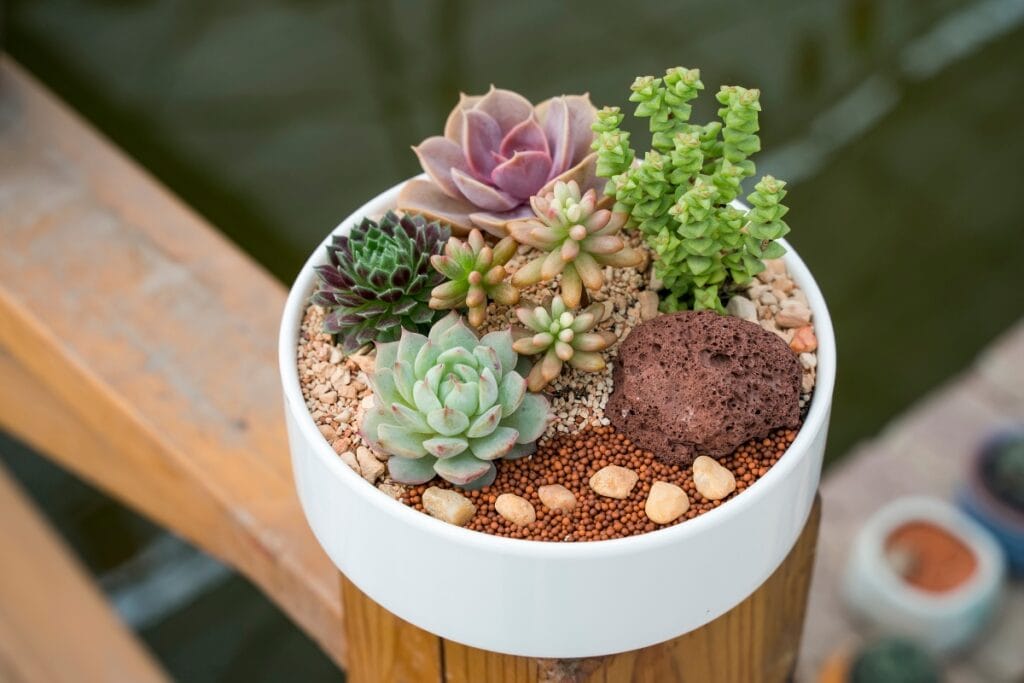
Designing a drought-resistant landscape doesn’t have to mean draining your budget. With the right planning, it’s possible to build a yard that is both water-efficient and affordable. The key is to use resources wisely, focus on long-term savings, and prioritize low-maintenance, climate-appropriate choices.
How Can Homeowners Save Money on Plant Selection and Installation?
Choosing the right plants is one of the most important decisions when planning a cost-effective drought-tolerant yard. Native plants are often the best choice because they are naturally suited to Georgia’s soil and climate. They typically need less water, fewer chemicals, and less upkeep once established. Since they are more widely available from local nurseries, they tend to be more affordable than exotic or specialty plants.
Another way to reduce costs is to take advantage of plant sales or seasonal discounts at garden centers. Community plant swaps and local gardening clubs can also be a great source for low-cost or even free plants. Starting from seeds or small containers, rather than mature plants, may require more patience but can significantly reduce your upfront investment.
Many homeowners choose to handle planting themselves, especially in small or moderately sized landscapes. With a little research and preparation, do-it-yourself installation is a practical option that saves money on labor. For larger projects, breaking the work into phases can help spread out expenses over time and allow more flexibility in your budget.
What Are Affordable Water-Saving Irrigation Options?
Water efficiency plays a big role in both environmental impact and ongoing costs. Fortunately, there are budget-friendly irrigation solutions that support sustainable landscaping. Drip irrigation kits, for example, are relatively inexpensive and easy to install. These systems deliver water slowly and directly to plant roots, helping to minimize evaporation and reduce water waste.
Soaker hoses are another low-cost option, especially effective in densely planted garden beds. They distribute water evenly along their length and work well when used early in the morning or late in the evening. Pairing these systems with a basic timer can help automate watering and prevent overuse.
Some utility providers in Georgia offer rebates for homeowners who install water-saving devices, such as rain sensors or high-efficiency irrigation systems. These programs can help offset the initial investment and make long-term water savings more accessible.
When Is Professional Landscaping Installation Recommended?
While many elements of a drought-resistant landscape can be handled by homeowners, there are times when hiring a professional is worth the cost. Projects that involve major grading, hardscaping, or complex irrigation systems may benefit from skilled installation. Experienced landscapers can also help ensure that your layout makes the best use of available sunlight, slope, and soil conditions.
Professional help may also mean access to wholesale plant pricing and reduced installation errors, which can save money in the long run. Whether you tackle the work yourself or bring in help, a well-planned landscape pays off through reduced water use, lower maintenance, and a yard that can thrive in Georgia’s challenging climate.
How Can You Enhance Biodiversity While Practicing Drought-Resistant Landscaping?
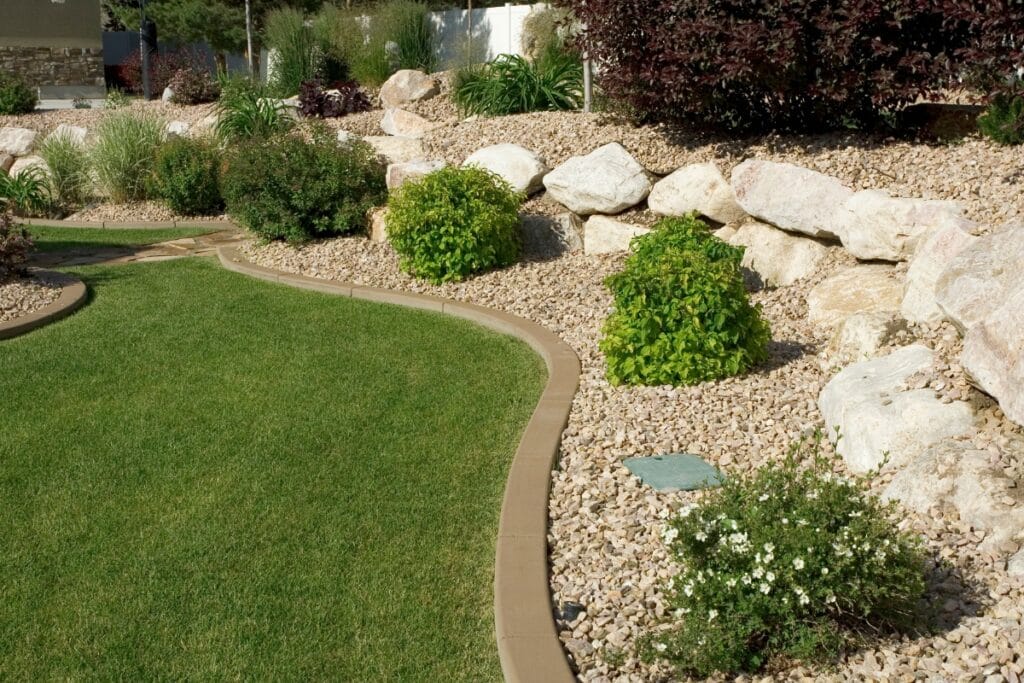
Creating a drought-resistant landscape doesn’t mean sacrificing the richness of a thriving garden. In fact, when designed with biodiversity in mind, water-efficient yards can support a wide range of plants, pollinators, and wildlife. The result is a more balanced ecosystem that is better equipped to handle pests, disease, and environmental changes.
Which Native Pollinators Benefit From Drought-Tolerant Gardens?
Georgia’s native pollinators include many species of bees, butterflies, and hummingbirds, all of which play essential roles in maintaining plant health and reproduction. Drought-tolerant plants that produce nectar and pollen, such as echinacea, milkweed, black-eyed Susan, lavender, and goldenrod, offer a dependable food source during the growing season. The key is to select a variety of plants that flower at different times throughout the year. This creates a continuous bloom cycle that supports pollinators from spring through fall.
These plants not only attract insects and birds but also help with pollination in nearby fruit and vegetable gardens. The presence of pollinators improves crop yield and strengthens the connection between ornamental landscaping and productive home gardening. Providing a range of plant types, from groundcovers to flowering shrubs, adds layers of habitat that different species can use for feeding and reproduction.
How to Create Wildlife-Friendly Habitats in Water-Wise Yards
Beyond pollinators, drought-tolerant gardens can become havens for other wildlife. Birds, frogs, beneficial insects, and small mammals all rely on varied habitats for food, shelter, and nesting. Homeowners can encourage biodiversity by including native shrubs, wildflowers, and perennial grasses that offer cover and nesting material. Creating small features like brush piles, rock groupings, or logs allows ground-dwelling species to take refuge.
Water features that recycle or conserve water, such as shallow bird baths or rain-fed basins, offer hydration without excessive irrigation. These features help support birds and insects during dry spells. Keeping a portion of your yard less manicured also encourages biodiversity. Allowing areas of leaf litter or wild vegetation to remain undisturbed can provide important shelter for overwintering insects or ground-nesting pollinators.
What Sustainable Practices Reduce Waste and Promote Soil Health?
Soil health is at the heart of any resilient landscape. Composting yard trimmings and kitchen scraps helps recycle nutrients back into the soil while reducing the need for store-bought fertilizers. Organic matter like compost or leaf mold increases the soil’s water retention capacity, which is especially important during dry weather.
Using organic mulch, such as shredded bark or pine straw, keeps the soil cool, reduces evaporation, and adds nutrients as it breaks down. Living mulches, such as low-growing groundcovers, serve a similar function while supporting insect life and suppressing weeds.
Adopting an integrated approach to pest management further reduces the need for chemicals. Attracting natural predators like ladybugs, birds, and beneficial wasps helps control common pests. Healthy, diverse gardens are more resistant to disease and require less intervention overall.
When drought-resistant landscaping is combined with biodiversity-focused design, it becomes a powerful tool for supporting the environment while reducing maintenance and water costs.
Frequently Asked Questions
Q: What are the primary benefits of using native plants in drought-resistant landscaping? A: Native plants are adapted to local conditions, require less water, and support regional biodiversity. Their deep root systems maximize water uptake during dry spells, reducing maintenance needs and enhancing soil stability, while also benefiting local wildlife.
Q: How can drip irrigation systems contribute to water conservation in Georgia yards? A: Drip irrigation delivers water directly to plant roots, minimizing evaporation and runoff. This system can save up to 30–50% more water than traditional sprinklers by ensuring that only the essential amount is used, and smart controllers further optimize watering based on current conditions.
Q: What role does soil amendment play in drought-resistant landscaping? A: Organic matter such as compost improves soil structure and water retention, enhancing nutrient availability and deep root growth. Proper soil amendments reduce runoff and help create a robust environment for drought-tolerant plants.
Q: Can I mix different irrigation methods to optimize water use? A: Yes, combining drip irrigation with soaker hoses or timer-integrated systems efficiently targets water to different areas of the landscape, reducing waste and providing ideal moisture levels where needed.
Q: How do sustainable practices in landscaping benefit long-term garden health? A: Sustainable practices like organic fertilization, mulching, and integrated pest management improve soil health and support biodiversity. Over time, these methods lower maintenance costs and help create a resilient, vibrant garden ecosystem.
Final Thoughts
Transforming your yard into a drought-resistant oasis is easier than you think—with the right plant choices, smart irrigation strategies, and expert guidance, your Georgia landscape can thrive even in the driest months. At Legacy Landscape Design, we specialize in crafting beautiful, water-wise landscaping that stand the test of time and weather. Ready to give your yard the sustainable makeover it deserves? Call us at 770-427-2026 or fill out the form on our website to start planning your drought-resistant landscape today!
